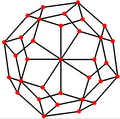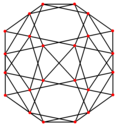Top Qs
Timeline
Chat
Perspective
Pentagonal icositetrahedron
Catalan solid with 24 faces From Wikipedia, the free encyclopedia
Remove ads
In geometry, a pentagonal icositetrahedron or pentagonal icosikaitetrahedron[1] is a Catalan solid which is the dual of the snub cube. In crystallography it is also called a gyroid.[2][3]
| Pentagonal icositetrahedron | |
|---|---|
 | |
| Type | Catalan |
| Conway notation | gC |
| Coxeter diagram | |
| Face polygon |  irregular pentagon |
| Faces | 24 |
| Edges | 60 |
| Vertices | 38 = 6 + 8 + 24 |
| Face configuration | V3.3.3.3.4 |
| Dihedral angle | 136° 18' 33' |
| Symmetry group | O, 1/2BC3, [4,3]+, 432 |
| Dual polyhedron | snub cube |
| Properties | convex, face-transitive, chiral |
 Net of a dextro form | |


It has two distinct forms, which are mirror images (or "enantiomorphs") of each other. They are termed dextro and laevo forms.
Remove ads
Construction
The pentagonal icositetrahedron can be constructed from a snub cube without taking the dual. Square pyramids are added to the six square faces of the snub cube, and triangular pyramids are added to the eight triangular faces that do not share an edge with a square. The pyramid heights are adjusted to make them coplanar with the other 24 triangular faces of the snub cube. The result is the pentagonal icositetrahedron.
Remove ads
Cartesian coordinates
Denote the tribonacci constant by . (See snub cube for a geometric explanation of the tribonacci constant.) Then Cartesian coordinates for the 38 vertices of a pentagonal icositetrahedron centered at the origin, are as follows:
- the 12 even permutations of (±1, ±(2t+1), ±t2) with an even number of minus signs
- the 12 odd permutations of (±1, ±(2t+1), ±t2) with an odd number of minus signs
- the 6 points (±t3, 0, 0), (0, ±t3, 0) and (0, 0, ±t3)
- the 8 points (±t2, ±t2, ±t2)
The convex hulls for these vertices[4] scaled by result in a unit circumradius octahedron centered at the origin, a unit cube centered at the origin scaled to , and an irregular chiral snub cube scaled to , as visualized in the figure below:
Remove ads
Geometry
Summarize
Perspective
The pentagonal faces have four angles of and one angle of . The pentagon has three short edges of unit length each, and two long edges of length . The acute angle is between the two long edges. The dihedral angle equals .
If its dual snub cube has unit edge length, its surface area and volume are:[5]
Remove ads
Orthogonal projections
The pentagonal icositetrahedron has three symmetry positions, two centered on vertices, and one on midedge.
Variations
Isohedral variations with the same chiral octahedral symmetry can be constructed with pentagonal faces having 3 edge lengths.
This variation shown can be constructed by adding pyramids to 6 square faces and 8 triangular faces of a snub cube such that the new triangular faces with 3 coplanar triangles merged into identical pentagon faces.
 Snub cube with augmented pyramids and merged faces |
 Pentagonal icositetrahedron |
 Net |
Remove ads
Related polyhedra and tilings
Summarize
Perspective

This polyhedron is topologically related as a part of sequence of polyhedra and tilings of pentagons with face configurations (V3.3.3.3.n). (The sequence progresses into tilings the hyperbolic plane to any n.) These face-transitive figures have (n32) rotational symmetry.
The pentagonal icositetrahedron is second in a series of dual snub polyhedra and tilings with face configuration V3.3.4.3.n.
The pentagonal icositetrahedron is one of a family of duals to the uniform polyhedra related to the cube and regular octahedron.
Remove ads
References
External links
Wikiwand - on
Seamless Wikipedia browsing. On steroids.
Remove ads










































